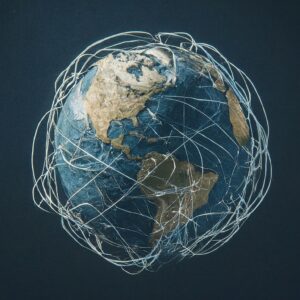On February 4, 2022, President Biden announced the extension of tariffs President Trump imposed on imported solar products in 2018. In 2018, the solar tariffs started at 30%, declining annually to 15% in 2022, when they were scheduled to expire on February 6.
President Biden’s decision nominally extends protection for U.S. solar manufacturers for another four years. The tariffs will continue at 15 percent, with slight quarterly declines in the tariff rates until they expire in February 2026.
However, President Biden also made several modifications to ease the tariffs that were welcomed by solar energy developers and installers. First, he agreed to an exclusion for bifacial panels that are favored by utility-scale solar developers that currently cannot rely on domestic suppliers. Second, the extension doubles the import quota on duty-free solar cells, which are the main components of solar panels, to 5 gigawatts (GW). Since there are no remaining U.S. solar cell producers, President Biden did not want to handicap U.S. solar module producers who depend on using imported solar cells.
President Biden’s decision on the solar tariffs reflects a balancing of competing interests. On one hand, tariffs on imports appeal to U.S. manufacturers and labor unions seeking to protect domestic manufacturing jobs from “unfair” imports. On the other hand, continuing the tariffs undermines President Biden’s efforts to fight climate change, expand clean energy and decarbonize the U.S. electricity sector by 2035. Also, the solar tariffs have hurt U.S. solar installers and developers who employ five times as many workers as solar manufacturers.
Layers of U.S. Solar Trade Protection
The extension of the Section 201 safeguard tariffs is just the latest chapter in the U.S. trade war that is trying to protect U.S. solar manufacturers.
- Round 1: Antidumping and countervailing duties (AD/CVD) – In 2012, AD/CVD duties were imposed on solar cells and modules from China, with another round of AD/CVD extended to a broader range of Chinese and Taiwanese solar modules in 2015.
- Round 2: Section 201 safeguard tariffs – In 2017, because the AD/CVD duties on solar products from China and Taiwan still were not enough to save U.S. solar manufacturers, they asked and got President Trump to impose safeguard tariffs on all imports of solar products. These are the tariffs President Biden just extended.
- Round 3: Section 301 China tariffs – In 2019, President Trump imposed Section 301 tariffs (25%) on selected Chinese products, including solar cells and modules, as well as other components used to make solar modules such as tempered solar glass, backsheets, and ethylene vinyl acetate (EVA) encapsulants.
Did the Solar Tariffs Work? No.
So, ten years into the solar trade wars, what have all these extra tariffs and AD/CVD duties gotten us?
These extra duties have artificially inflated costs to U.S. solar developers and installers so that prices for U.S. solar products are significantly (55%) higher than elsewhere in the world. Proponents of the tariffs argue that the continued soaring U.S. demand for solar products shows the tariffs were easily passed through and absorbed. But a recent economic study indicates that U.S. solar installations would have been 17.2 percent higher if the tariffs had not been imposed.
These tariffs have done little to bring back solar cell production or foster the growth of U.S. solar module production enough to meaningfully meet U.S. demand. Most of the U.S. solar producers at the start of the solar wars ten years ago have shut down or no longer produce solar products, including the two U.S. producers that filed the AD/CVD and Section 201 petitions (Solarworld, Suniva). Despite these significant closures, several solar module plants have opened or expanded in the U.S. since 2019. Many of the larger new U.S. solar plant openings (Hanwha in Dalton, GA; LG in Huntsville, AL; Jinko Solar in Jacksonville, FL) are affiliated with Korean or Chinese solar producers.
But the U.S. solar manufacturing industry remains small and can only supply a small fraction of the total U.S. demand for solar products. The U.S. International Trade Commission noted that in 2020 total U.S. solar module production capacity was 3.8 million kilowatts (kW), and total U.S. solar production was 2.1 million kW. Total U.S. solar module demand was 21.0 million kW. The ITC report further noted that U.S.-produced solar modules accounted for 10-15% of total U.S. demand from 2018-20. Given the limited production capacity of U.S. solar modules, imports are clearly needed to meet the increasing U.S. demand for solar modules.
China Dominates the Entire Solar Supply Chain
Moreover, given how small and limited the U.S. solar industry is, it is doubtful that the government can impose a tariff/ duty wall high enough protect the remaining U.S. solar producers. Even if enough U.S. solar module producers survive, these survivors likely are still going to be dependent on China’s market control of the entire solar supply chain from start to finish.
- Polysilicon – Polysilicon is used to make not only solar cells, but also semiconductors. China accounted for 76% of global production of polysilicon in 2020. Four Chinese producers with facilities in Xinjiang province account for 65% of that Chinese production.
- Wafers – Polysilicon is processed into ingots, which are then sliced into wafers. China accounted for 96 percent of world wafer production capacity in 2020. Just six Chinese producers account for 88 percent of global production capacity.
- Solar Cells – In 2020, China was the world’s largest producer of solar cells, with 78% of the global production. Because of U.S. tariffs on Chinese solar cells, most solar cells are now imported to the U.S. from Malaysia, Vietnam, South Korea, and Thailand.
- Solar Glass – Solar modules use a special type of photovoltaic glass. China’s share of the global solar glass market has been above 90%, with five Chinese glass producers controlling about 70% of the market in 2019.
Fairly or unfairly, China now has a huge lead over the United States in developing green renewable energy (solar, wind, hydro, geothermal, bioenergy). In the U.S., advocating for climate-change initiatives and government-supported “green” industrial policies are still politically sensitive (hello, Senator Manchin). This makes it impossible for the U.S. government to take comprehensive or decisive action to confront the Chinese dominance in solar and other renewable energy industries. With this decision, President Biden has at least recognized that tariffs alone are not the answer to saving U.S. solar manufacturers, and that U.S. solar developers and installers also provide important American jobs.
Splitting the baby on the solar tariffs will result in wishy-washy results across the entire U.S. solar industry. Maintaining the tariffs has not and will not provide enough help to the remaining U.S. solar manufacturers. The tariffs will provide enough cost drag to slow down the growth of U.S. solar developers and installers. Maybe that no one is completely happy with President Biden’s decision means it was a reasonably fair and balanced decision. To me, the solar tariffs aren’t really helping anyone, but are causing lots of pain up and down the solar supply chain.

























